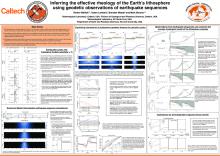Inferring the effective rheology of the lithosphere and heterogeneities in rheological properties using geodetic observations of earthquake sequences
Rishav Mallick, Valere R. Lambert, Brendan J. Meade, & Mark SimonsSubmitted September 11, 2022, SCEC Contribution #12191, 2022 SCEC Annual Meeting Poster #072 (PDF)
The solid Earth displays both elastic and viscous behaviors, with their relative contribution depending on the observational time window and the details of stress evolution. While studies of elastic wave propagation can estimate spatially varying elastic moduli, by assuming Hookean elasticity, similar studies of viscous parameter estimation are lacking. One of the main reasons is that the exact formulation of the viscous constitutive relationship of the crust-mantle system remains poorly known; multiple rheological formulations (linear Maxwell, power-law and Burgers) are able to recreate the deformation kinematics observed over limited time windows. In this study, we use numerical simulations of periodic earthquake cycles for a 2-D strike-slip fault in a frictional-viscoelastic medium to highlight how combining geodetic observations from the post-seismic and inter-seismic allows us to reject a homogeneous linear Maxwell model as a candidate rheology. However, spatially heterogeneous viscosities in a linear Maxwell model (a low viscosity core surrounded by a high viscosity bulk), homogeneous power-law and Burgers rheologies are all consistent with typical observations. Distinguishing between these models is possible if we go beyond periodic earthquakes, and instead investigate earthquake sequence deformation. For a typical two-event and three-event sequence, we are readily able to discriminate between the aforementioned candidate rheological formulations. Estimating an appropriate constitutive relationship for the crust-mantle system has implications for problems in stress interactions between neighboring faults, since viscoelasticity promotes the propagation of elevated stress levels deeper into block interiors than predictions from typical frictional-elastic models. The time-lag and increased amplitude of viscoelastically modulated stresses may be crucial to estimate regional seismic hazard and risk.
Key Words
rheology, viscoelasticity, friction, geodesy, deformation
Citation
Mallick, R., Lambert, V. R., Meade, B. J., & Simons, M. (2022, 09). Inferring the effective rheology of the lithosphere and heterogeneities in rheological properties using geodetic observations of earthquake sequences. Poster Presentation at 2022 SCEC Annual Meeting.
Related Projects & Working Groups
Tectonic Geodesy




